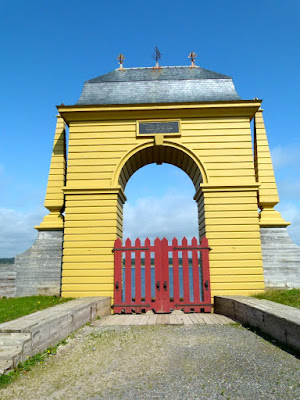The Largest Historical Recreation In North America
The Fortress of Louisburg is a National Canadian Treasure.
If you are interested in early Canadian history and want to learn something, then Read On.
If you are interested in early Canadian history and want to learn something, then Read On.
The restoration carpenters, recreationist staff and Parks Canada should be commended for the job they have done at this site to preserve an important and pivotal part of our history ... kudos to all!
This all started in 1713. A great European war had just ended, and one consequence of that, was the surrender of France’s outposts in Newfoundland and the Bay of Fundy. Its coastal holdings reduced to Cape Breton and Prince Edward Island, France sought a better replacement for what had been lost.
But, why here at Louisbourg?
Well, it was to be a fishing port and the same juncture of cold currents and warmer land that breeds the fog brings the codfish close to shore. It was to be a port of trade, and the harbour is large and good and rarely ice-choked.
Goods for export packed in barrels ... mostly codfish.

Goods for export packed in barrels ... mostly codfish.

It was to be a military base, for no one doubted there would be future wars, and this site looked defensible. As Cape Breton Island became Île Royale and its harbours became settlements, Louisbourg became a colonial capital and a substantial town.
Who came?
Frenchmen. Officers and men of the colonial regular troops came first, with some officials of the colonial service.
Gate-keepers and Patrol ...
Gate-keepers and Patrol ...
Fishermen from Newfoundland and some merchants joined them. More began to
immigrate from France and a few from Quebec and Acadia: artisans and sailors and clerks but few farmers - this was never an agricultural colony. Wives and sisters came too, and new families began to raise children. Householders had their servants and there were slaves too, most of them brought north from the Caribbean but also a few native North American slaves.
They brought out hired men to labour, and more troops, women, farmers to tend sheep and goats.

Priests and nuns and medical brothers served them. Innkeepers, bakers and laundresses found a market for their services. By the 1740s, 2000 people lived in Louisbourg and more in the outports.
And they had visitors.
Every summer hundreds of transients swelled the population. Fleets of Basques and Bretons and Normans came early in the spring to join the fishing industry. Mi’kmaw allies visited to parley and trade. French naval frigates and merchant ships from every port of France shared the harbour with traders from New England and Acadia, Quebec and the Caribbean. The visitors hauled away cargoes of cod and in exchange they brought nearly all that the colonists ate and wore and used. News and new laces came and went with the trade, and as long as the sealanes were open Louisbourg was never isolated, though a thousand miles of forest stretched inland.
Louisbourg grew for three decades. Defined by the fortifications rising around it and ruled by royal governors closely supervised by Versailles, it served imperial aims by its commercial prowess as by its military strength. Then in 1744, Britain and France went to war. At first the French in Île Royale took the offensive, but the tables turned as New England’s greater numbers began to tell. Louisbourg was attacked and conquered in 1745.
The Garrison. Left was the Governor's quarters for family and the right was soldiers barracks.
The Garrison. Left was the Governor's quarters for family and the right was soldiers barracks.

How could such a fortress fall?
Then it became French again. In 1748 the terms of Anglo-French truce regained Île Royale for France. In 1749 the exiles flooded back. Trade and fishing were resumed, the garrison tripled its numbers, and the town grew larger than ever, but the truce lasted only a few years.
Louisbourg was attacked again in 1758 and the outcome of the second siege was closer to a foregone conclusion, British sea power assembled a crushingly superior force before Louisbourg that spring. The defenders dug in above every landing site east and west of Louisbourg, but on June 8, 1758 the British army got ashore at Kennington Cove. There was another siege. Louisbourg capitulated late in July and once again saw its people exiled.
That was the end.
A community that had thrived in peace failed to survive the recurring wars of the eighteenth century. In 1760 the British government had the fortifications demolished. Three years later peace confirmed British possession of all New France. The people of Louisbourg would never return though that year some of them helped found a new colony on Saint-Pierre and Miquelon. The siege-battered town began to crumble.
The shaming stage (for crimes against the community), interesting roof vents, steeple towers, timber frame construction, a typical village scene (gardens, livestock fencing, rooftops) .


Crusty ... I luv Canadian History!























No comments:
Post a Comment
Your comments, suggestions, observations and even opinions are welcome ... please leave some!